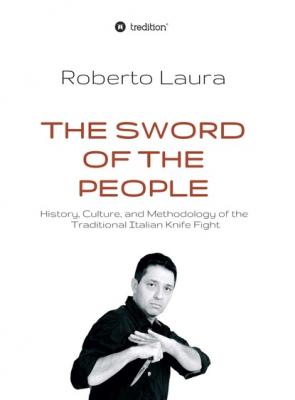ТОП просматриваемых книг сайта:
The Sword of the People. Roberto Laura
Читать онлайн.Название The Sword of the People
Год выпуска 0
isbn 9783347056480
Автор произведения Roberto Laura
Жанр Учебная литература
Издательство Readbox publishing GmbH
5.3.3 Regole di Scuola - the (Technical) Rules of the School
5.3.3.1 Saluto
5.3.3.2 Giro / Girata
5.3.3.3 Chiamata
5.3.3.4 Uscita con sparata di colpo
5.3.3.5 Mezzzo ponte
5.3.3.6 Parata chiusa
5.3.3.7 Schiacciamento / Schiacciata
5.3.3.8 Quartiatura
5.3.3.9 Mezza galeotta, mezza galeotta del mancino, galeone
5.3.3.10 Catenella
5.3.3.11 Specchietto
5.3.3.12 Chiusure
5.3.3.13 Calci
5.3.3.14 Fuori Colpo
5.3.3.15 Special Features
5.4 The Scherma Salentina: Knife Fencing from Salento
5.4.1 Introduction
5.4.2 The Interview
5.4.3 A Narrative
5.5 Recapitulation
Chapter 6
Schools of the Hall or Duel: Regional Developments in Sicily
6.1 The History of Sicily
6.2 The Numerous Secret Schools of the Knife in Sicily
6.2.1 Introduction
6.2.2 The Knife Duel in Italian Verism
6.3 The Big Five and a Hybrid - A General Overview
6.3.1 Scuola siracusana – The Knife and Stick Tradition from Syracuse
6.3.2 Scuola fiorata – The Flowery School
6.3.3 Scuola ruotata - The Circling School
6.4 The scuola ruotata - A Closer Look
6.4.1 Overview
6.4.2 The Lessons – a Brief Technical Introduction Coltello stretto
Coltello largo
Colpi d`attacco
Colpi d`assalto
Passi giranti
Quattro angoli
6.4.3. The piante – The Fighting Stances respectively Guards
6.5 Recapitulation
Chapter 7
Schools of Defense: Regional Developments in Apulia
7.1 Introduction
7.2 The System
7.2.1 The icons of the System – the Knife and the Rosary
7.2.2 The Method of the Knife with the Cord
7.2.3 Didactics
7.2.3.1 The Nominees
7.2.4 Pose, the Fencing Positions
7.2.5 First Steps: Grip Variants
7.2.6 The Mostranze
7.2.6.1 First Steps I: The Salvos
7.2.6.2 First Steps II: Spassi – the Passing By
7.2.6.3 First Steps III: The Irrational Side
7.2.7 The Knife in Conjunction with Other Objects
7.2.8 The Monsignore – The Reverend
7.2.9 The improvvisata – System-specific Sparring
7.3 Recapitulation
Chapter 8
Bastone genovese – The Genoese Stick
8.1 A General Introduction to the Methods of the North
8.2 The bastone genovese: An Introduction
8.3 The Ancient Two-Handed Stick from Genoa
8.3.1 The Nature of the Stick and a Very Rough Overview of Techniques
8.4 The Walking Stick
8.5 The Unarmed Arts of the Genoese
8.6 The Bone Crusher, desfa osse
8.7 The Knife – scherma du tagan zeneisê
8.7.1 Basic Techniques of the Knife School
8.8 Recapitulation
Chapter 9
Traditional Knives for Dueling and Defense
9.1 Introduction
9.2 Genoa and Corsica
9.2.1 Genoa
9.2.2 Corsica
9.3 Latium
9.4 Campania
9.5 Basilicata
9.6 Calabria
9.7 Sicily
9.8 Recapitulation
Acknowledgments
Vita
Images
Bibliography
Introduction
“With this project, it should be noted that in all of southern Italy, since the beginning of rural life in Rome, the knife was not looked upon as a treacherous weapon but as the sword of the people.”
– Conrado Tommasi Crudeli, La Sicilia nel 1871, Florence 1871
This book serves to give an understanding of the ways of the traditional Italian fencing schools with knives and sticks, thus contributing to their preservation. It does not, however, claim to be the complete and final word on the subject.
But how should one tell the story of the Southern Italian Knife? Until a few years ago, these ancient arts were still veiled in shadow to the uninitiated. It is a history of secrecy, of omertà. Oaths and covenants, as well as the fear of retribution, but also the pride of belonging to a secret and chivalrous society, prevented the secrets of the blade from penetrating into foreign ears. The fear of leaving traces, being unmasked or exposed, and as well illiteracy, which was present in the lower social strata of Southern Italy in the 19th century, also produced a culture of pure oral tradition. And so my research for this book, which I had already been thinking of for many years, began in the dark.
At first it was all marked by speculation. Over the course of years, I therefore dealt not only physically, but also mentally and academically, with this subculture of my country of birth. I read books that, at first glance, have less to do with the subject matter of the knife, but rather devote themselves to the history, art, and culture of Italy. To be able to weigh what a substance is, or what it is not, one should know everything to which it relates. And only through this knowledge can the probable be distinguished from the unlikely. And so, I followed all tracks and rumors, like a lynx that spots even the smallest hint, or like an owl, listening to every whisper, no matter how silent. And the fact that this search was so mysterious only made it more appealing. It could not be any less mysterious because of the lack of documentation or scant written evidence. (That was the “why,” to walk on) Thus, I embarked on this journey, the first of many journeys now. I met Masters, and even those who only called themselves the

